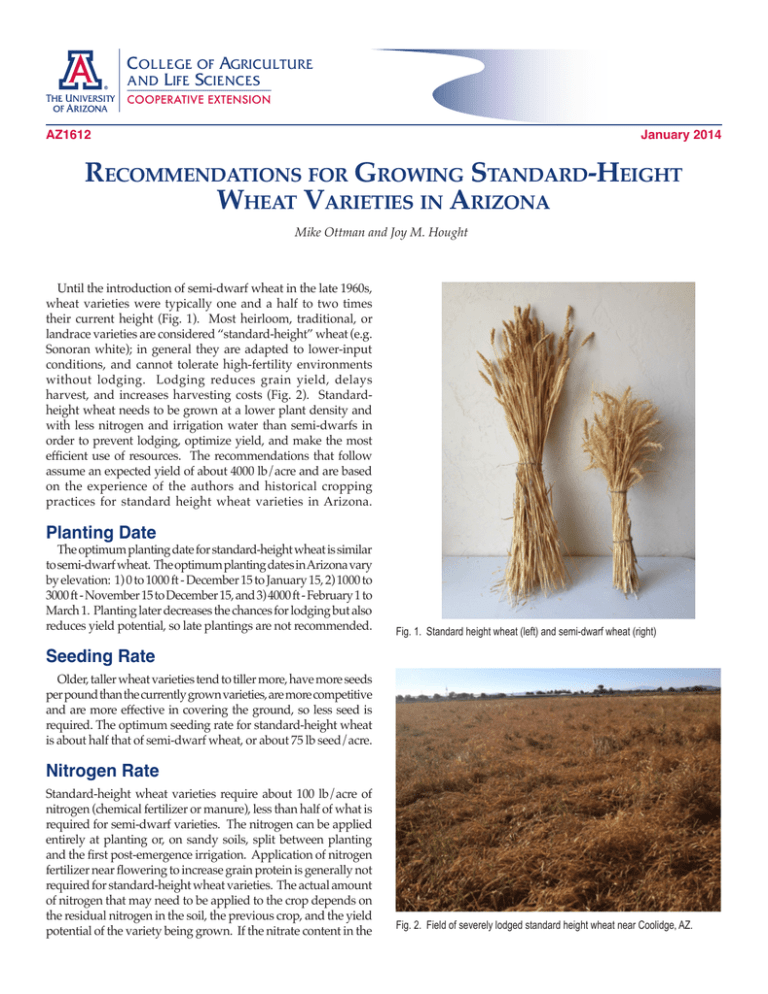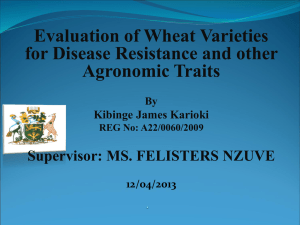R G s
advertisement

C OLLEGE OF AGRICULTURE AND LIFE SCIENCES COOPERATIVE EXTENSION AZ1612 January 2014 Recommendations for Growing Standard-Height Wheat Varieties in Arizona Mike Ottman and Joy M. Hought Until the introduction of semi-dwarf wheat in the late 1960s, wheat varieties were typically one and a half to two times their current height (Fig. 1). Most heirloom, traditional, or landrace varieties are considered “standard-height” wheat (e.g. Sonoran white); in general they are adapted to lower-input conditions, and cannot tolerate high-fertility environments without lodging. Lodging reduces grain yield, delays harvest, and increases harvesting costs (Fig. 2). Standardheight wheat needs to be grown at a lower plant density and with less nitrogen and irrigation water than semi-dwarfs in order to prevent lodging, optimize yield, and make the most efficient use of resources. The recommendations that follow assume an expected yield of about 4000 lb/acre and are based on the experience of the authors and historical cropping practices for standard height wheat varieties in Arizona. Planting Date The optimum planting date for standard-height wheat is similar to semi-dwarf wheat. The optimum planting dates in Arizona vary by elevation: 1) 0 to 1000 ft - December 15 to January 15, 2) 1000 to 3000 ft - November 15 to December 15, and 3) 4000 ft - February 1 to March 1. Planting later decreases the chances for lodging but also reduces yield potential, so late plantings are not recommended. Fig. 1. Standard height wheat (left) and semi-dwarf wheat (right) Seeding Rate Older, taller wheat varieties tend to tiller more, have more seeds per pound than the currently grown varieties, are more competitive and are more effective in covering the ground, so less seed is required. The optimum seeding rate for standard-height wheat is about half that of semi-dwarf wheat, or about 75 lb seed/acre. Nitrogen Rate Standard-height wheat varieties require about 100 lb/acre of nitrogen (chemical fertilizer or manure), less than half of what is required for semi-dwarf varieties. The nitrogen can be applied entirely at planting or, on sandy soils, split between planting and the first post-emergence irrigation. Application of nitrogen fertilizer near flowering to increase grain protein is generally not required for standard-height wheat varieties. The actual amount of nitrogen that may need to be applied to the crop depends on the residual nitrogen in the soil, the previous crop, and the yield potential of the variety being grown. If the nitrate content in the Fig. 2. Field of severely lodged standard height wheat near Coolidge, AZ. top foot of soil is greater than 25 ppm nitrate-N, then the soil can provide the nitrogen needs of the crop and no nitrogen should be applied. Likewise, if the previous crop was alfalfa or a similar legume, then nitrogen fertilization may not be necessary except on extremely sandy soils. If yields different than 4000 lb/acre are anticipated, the nitrogen rate of 100 lb/acre of nitrogen should be adjusted proportionately, that is, 25 lb/acre of nitrogen applied per 1000 lb/acre of expected grain yield. Phosphorus Rate Phosphorus fertilizer is unlikely to increase the yield of standard-height wheat varieties, except if the soil is extremely low in phosphate (<7 ppm bicarbonate extractable P). Even in the cases where a yield response is obtained, the cost of the fertilizer may not be paid for by the relatively small increase in grain yield obtained. Therefore, phosphate fertilizer is not generally recommended for standard-height wheat varieties. Irrigation Increasing water applications does not benefit standard-height wheat varieties to the same degree as semi-dwarfs due to the lower yield potential of standard-height varieties. Only 3 to 5 flood irrigations are required, compared to 5 to 7 irrigations with semi-dwarf varieties. For a sandy loam soil, about 4 irrigations are required and may be applied at planting, early jointing, boot, and the beginning of the soft dough stage. One less irrigation may be needed on heavier soils and one more on lighter soils. More or less irrigation water may be required based on seasonal rainfall. C OLLEGE OF AGRICULTURE AND LIFE SCIENCES COOPERATIVE EXTENSION The University of Arizona College of Agriculture and Life Sciences Tucson, Arizona 85721 Mike Ottman School of Plant Sciences-Ext, Agronomy Specialist Joy M. Hought Seed School Director For Native Seeds/Search Based In Tucson Contact: Mike Ottman mottman@cals.arizona.edu This information has been reviewed by University faculty. cals.arizona.edu/pubs/crops/az1612.pdf Other titles from Arizona Cooperative Extension can be found at: cals.arizona.edu/pubs Any products, services or organizations that are mentioned, shown or indirectly implied in this publication do not imply endorsement by The University of Arizona. Issued in furtherance of Cooperative Extension work, acts of May 8 and June 30, 1914, in cooperation with the U.S. Department of Agriculture, Jeffrey C. Silvertooth, Associate Dean & Director, Extension & Economic Development, College of Agriculture Life Sciences, The University of Arizona. The University of Arizona is an equal opportunity, affirmative action institution. The University does not discriminate on the basis of race, color, religion, sex, national origin, age, disability, veteran status, or sexual orientation in its programs and activities. 2 The University of Arizona - College of Agriculture and Life Sciences - Cooperative Extension




